Analysis and Design of Automated Tourist System: Project Report
VerifiedAdded on 2020/01/28
|17
|5173
|1657
Report
AI Summary
This report focuses on the system analysis and design for a travel agency, specifically for an automated tourist system. It begins with an evaluation of different SDLC models, recommending the rapid prototyping model for its adaptability and ability to gather user feedback. The report then explores the importance of SDLC in system investigation, detailing the various stages involved. Components of a feasibility report are discussed, along with fact-finding techniques like questionnaires and interviews. The current system of the travel agency is investigated to identify business needs, leading to the creation of a data flow diagram up to level 2. The report also covers documentation supporting the system investigation and evaluates how user and system requirements are addressed throughout the SDLC, ensuring quality at each stage. Finally, the report recommends rapid prototyping for the travel agency's automated tourist system, emphasizing the importance of gathering user feedback to identify and address potential issues before the full-scale software launch.
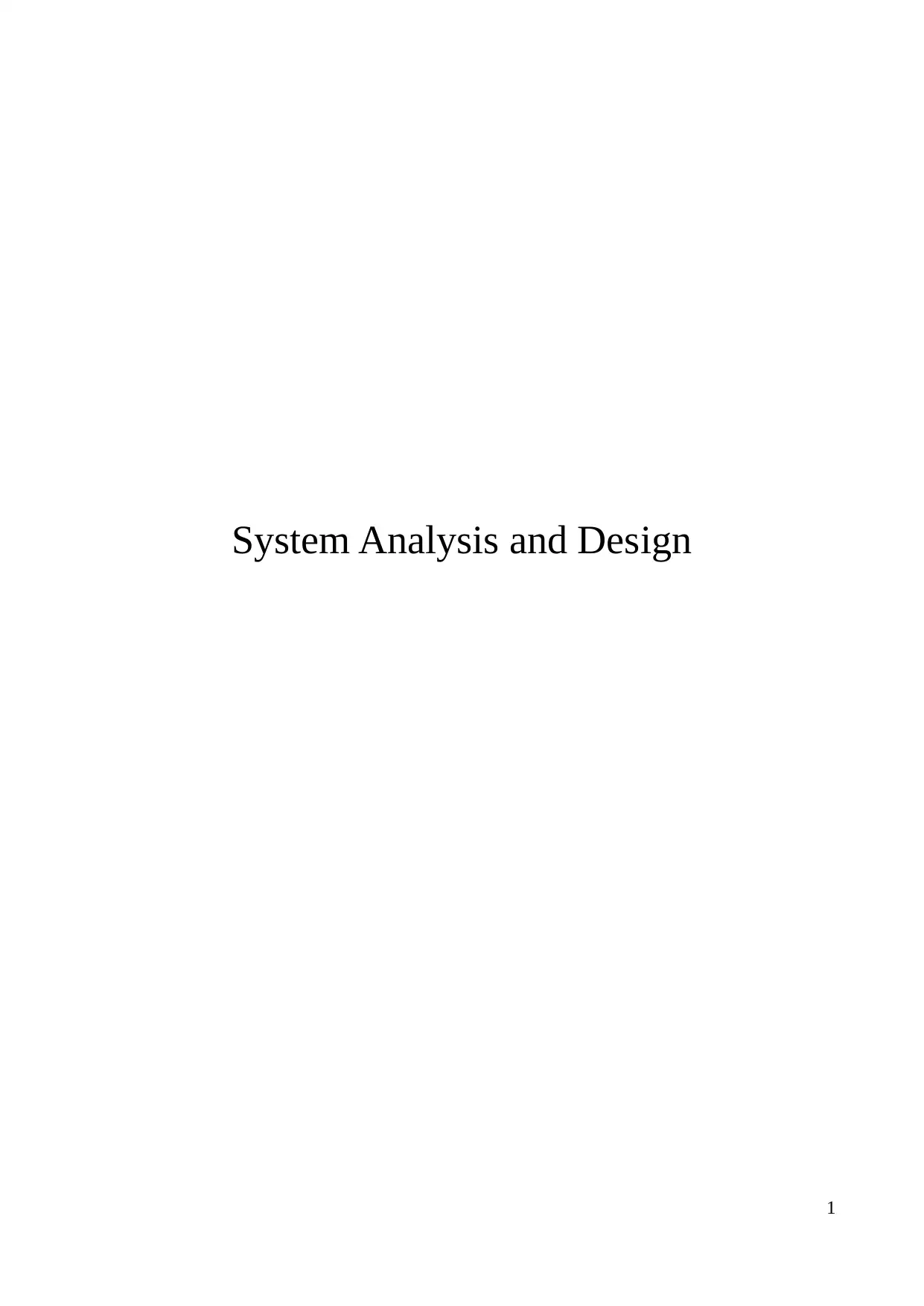
System Analysis and Design
1
1
Paraphrase This Document
Need a fresh take? Get an instant paraphrase of this document with our AI Paraphraser
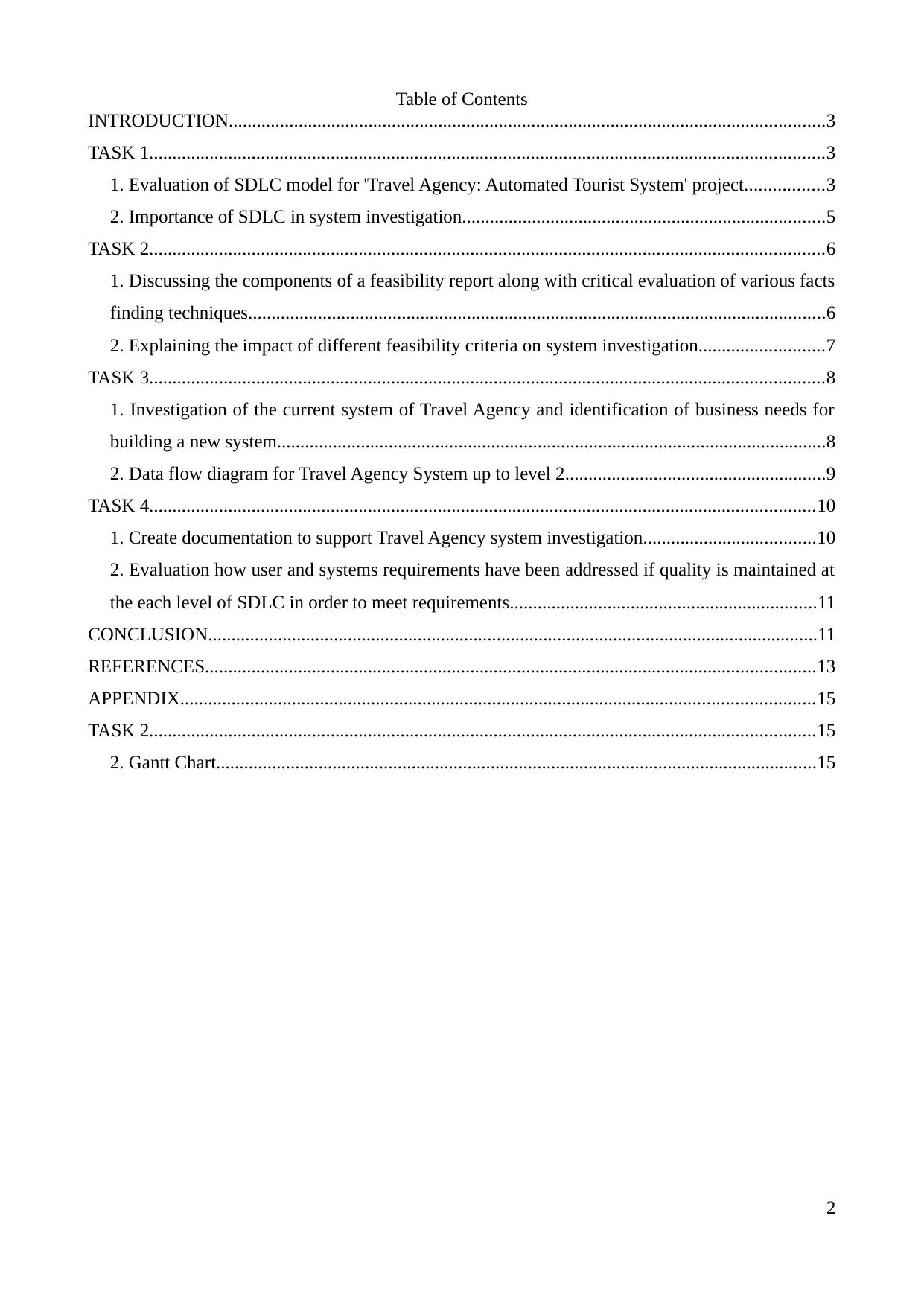
Table of Contents
INTRODUCTION................................................................................................................................3
TASK 1.................................................................................................................................................3
1. Evaluation of SDLC model for 'Travel Agency: Automated Tourist System' project.................3
2. Importance of SDLC in system investigation..............................................................................5
TASK 2.................................................................................................................................................6
1. Discussing the components of a feasibility report along with critical evaluation of various facts
finding techniques............................................................................................................................6
2. Explaining the impact of different feasibility criteria on system investigation...........................7
TASK 3.................................................................................................................................................8
1. Investigation of the current system of Travel Agency and identification of business needs for
building a new system......................................................................................................................8
2. Data flow diagram for Travel Agency System up to level 2........................................................9
TASK 4...............................................................................................................................................10
1. Create documentation to support Travel Agency system investigation.....................................10
2. Evaluation how user and systems requirements have been addressed if quality is maintained at
the each level of SDLC in order to meet requirements..................................................................11
CONCLUSION...................................................................................................................................11
REFERENCES...................................................................................................................................13
APPENDIX........................................................................................................................................15
TASK 2...............................................................................................................................................15
2. Gantt Chart.................................................................................................................................15
2
INTRODUCTION................................................................................................................................3
TASK 1.................................................................................................................................................3
1. Evaluation of SDLC model for 'Travel Agency: Automated Tourist System' project.................3
2. Importance of SDLC in system investigation..............................................................................5
TASK 2.................................................................................................................................................6
1. Discussing the components of a feasibility report along with critical evaluation of various facts
finding techniques............................................................................................................................6
2. Explaining the impact of different feasibility criteria on system investigation...........................7
TASK 3.................................................................................................................................................8
1. Investigation of the current system of Travel Agency and identification of business needs for
building a new system......................................................................................................................8
2. Data flow diagram for Travel Agency System up to level 2........................................................9
TASK 4...............................................................................................................................................10
1. Create documentation to support Travel Agency system investigation.....................................10
2. Evaluation how user and systems requirements have been addressed if quality is maintained at
the each level of SDLC in order to meet requirements..................................................................11
CONCLUSION...................................................................................................................................11
REFERENCES...................................................................................................................................13
APPENDIX........................................................................................................................................15
TASK 2...............................................................................................................................................15
2. Gantt Chart.................................................................................................................................15
2
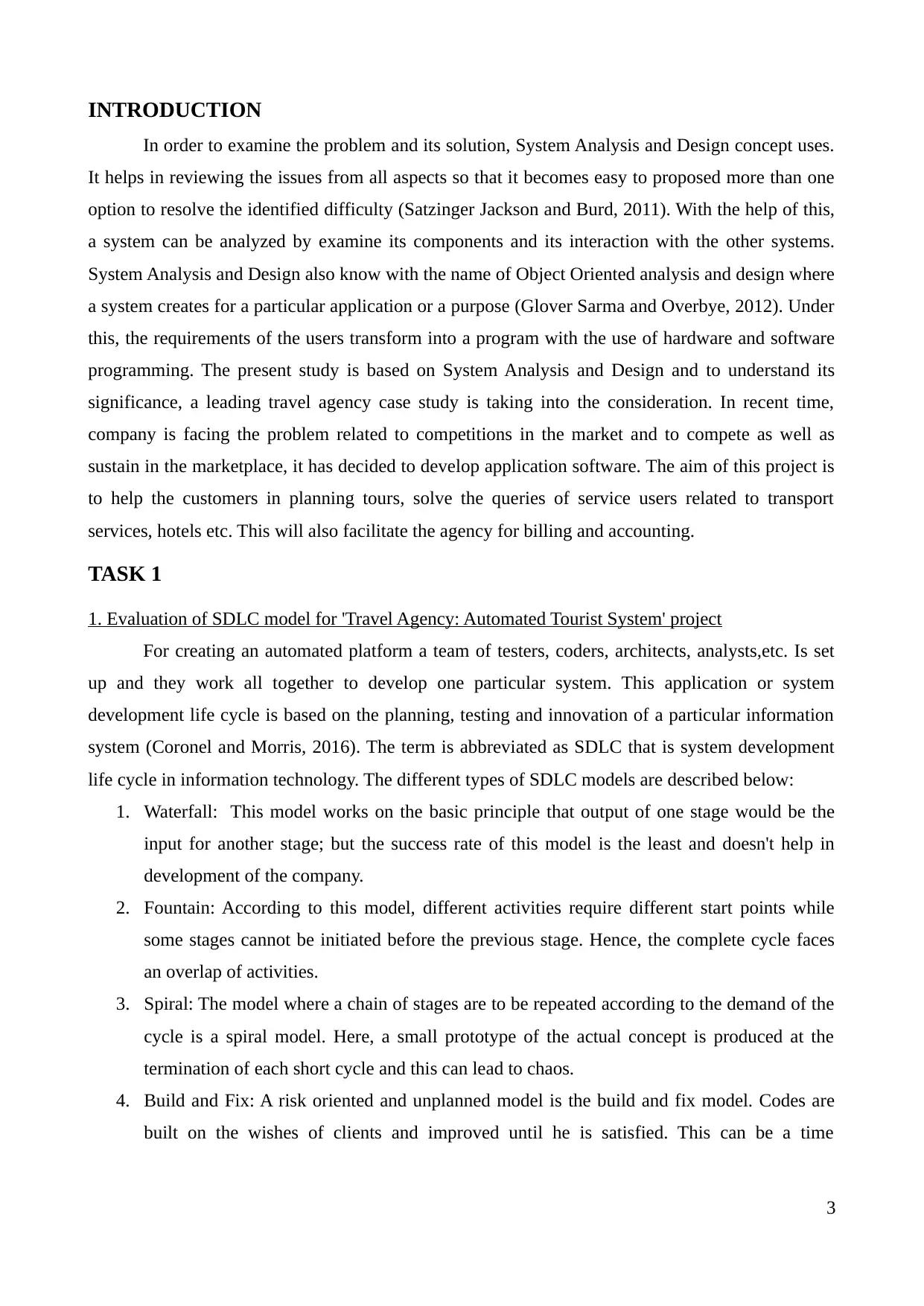
INTRODUCTION
In order to examine the problem and its solution, System Analysis and Design concept uses.
It helps in reviewing the issues from all aspects so that it becomes easy to proposed more than one
option to resolve the identified difficulty (Satzinger Jackson and Burd, 2011). With the help of this,
a system can be analyzed by examine its components and its interaction with the other systems.
System Analysis and Design also know with the name of Object Oriented analysis and design where
a system creates for a particular application or a purpose (Glover Sarma and Overbye, 2012). Under
this, the requirements of the users transform into a program with the use of hardware and software
programming. The present study is based on System Analysis and Design and to understand its
significance, a leading travel agency case study is taking into the consideration. In recent time,
company is facing the problem related to competitions in the market and to compete as well as
sustain in the marketplace, it has decided to develop application software. The aim of this project is
to help the customers in planning tours, solve the queries of service users related to transport
services, hotels etc. This will also facilitate the agency for billing and accounting.
TASK 1
1. Evaluation of SDLC model for 'Travel Agency: Automated Tourist System' project
For creating an automated platform a team of testers, coders, architects, analysts,etc. Is set
up and they work all together to develop one particular system. This application or system
development life cycle is based on the planning, testing and innovation of a particular information
system (Coronel and Morris, 2016). The term is abbreviated as SDLC that is system development
life cycle in information technology. The different types of SDLC models are described below:
1. Waterfall: This model works on the basic principle that output of one stage would be the
input for another stage; but the success rate of this model is the least and doesn't help in
development of the company.
2. Fountain: According to this model, different activities require different start points while
some stages cannot be initiated before the previous stage. Hence, the complete cycle faces
an overlap of activities.
3. Spiral: The model where a chain of stages are to be repeated according to the demand of the
cycle is a spiral model. Here, a small prototype of the actual concept is produced at the
termination of each short cycle and this can lead to chaos.
4. Build and Fix: A risk oriented and unplanned model is the build and fix model. Codes are
built on the wishes of clients and improved until he is satisfied. This can be a time
3
In order to examine the problem and its solution, System Analysis and Design concept uses.
It helps in reviewing the issues from all aspects so that it becomes easy to proposed more than one
option to resolve the identified difficulty (Satzinger Jackson and Burd, 2011). With the help of this,
a system can be analyzed by examine its components and its interaction with the other systems.
System Analysis and Design also know with the name of Object Oriented analysis and design where
a system creates for a particular application or a purpose (Glover Sarma and Overbye, 2012). Under
this, the requirements of the users transform into a program with the use of hardware and software
programming. The present study is based on System Analysis and Design and to understand its
significance, a leading travel agency case study is taking into the consideration. In recent time,
company is facing the problem related to competitions in the market and to compete as well as
sustain in the marketplace, it has decided to develop application software. The aim of this project is
to help the customers in planning tours, solve the queries of service users related to transport
services, hotels etc. This will also facilitate the agency for billing and accounting.
TASK 1
1. Evaluation of SDLC model for 'Travel Agency: Automated Tourist System' project
For creating an automated platform a team of testers, coders, architects, analysts,etc. Is set
up and they work all together to develop one particular system. This application or system
development life cycle is based on the planning, testing and innovation of a particular information
system (Coronel and Morris, 2016). The term is abbreviated as SDLC that is system development
life cycle in information technology. The different types of SDLC models are described below:
1. Waterfall: This model works on the basic principle that output of one stage would be the
input for another stage; but the success rate of this model is the least and doesn't help in
development of the company.
2. Fountain: According to this model, different activities require different start points while
some stages cannot be initiated before the previous stage. Hence, the complete cycle faces
an overlap of activities.
3. Spiral: The model where a chain of stages are to be repeated according to the demand of the
cycle is a spiral model. Here, a small prototype of the actual concept is produced at the
termination of each short cycle and this can lead to chaos.
4. Build and Fix: A risk oriented and unplanned model is the build and fix model. Codes are
built on the wishes of clients and improved until he is satisfied. This can be a time
3
⊘ This is a preview!⊘
Do you want full access?
Subscribe today to unlock all pages.

Trusted by 1+ million students worldwide
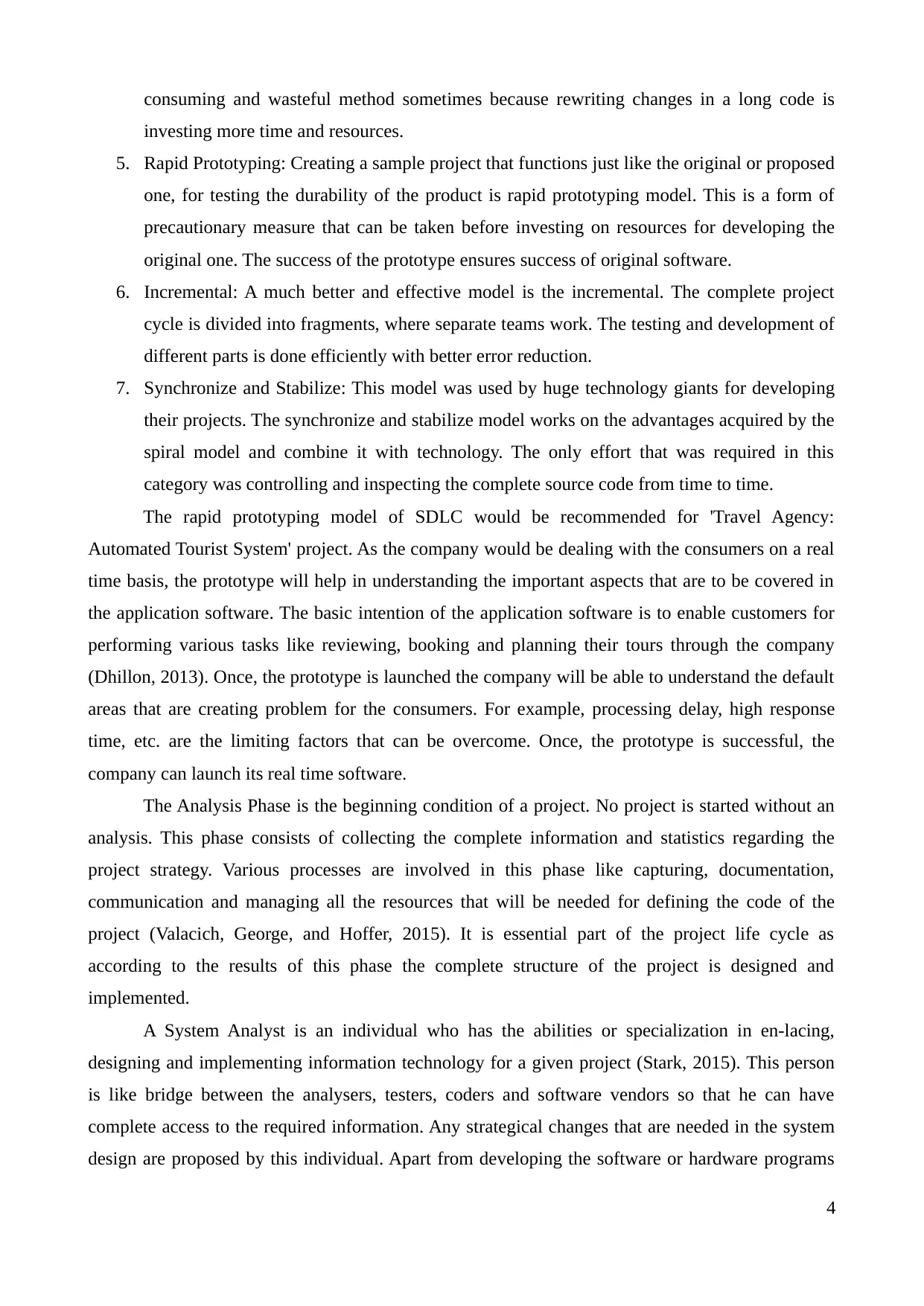
consuming and wasteful method sometimes because rewriting changes in a long code is
investing more time and resources.
5. Rapid Prototyping: Creating a sample project that functions just like the original or proposed
one, for testing the durability of the product is rapid prototyping model. This is a form of
precautionary measure that can be taken before investing on resources for developing the
original one. The success of the prototype ensures success of original software.
6. Incremental: A much better and effective model is the incremental. The complete project
cycle is divided into fragments, where separate teams work. The testing and development of
different parts is done efficiently with better error reduction.
7. Synchronize and Stabilize: This model was used by huge technology giants for developing
their projects. The synchronize and stabilize model works on the advantages acquired by the
spiral model and combine it with technology. The only effort that was required in this
category was controlling and inspecting the complete source code from time to time.
The rapid prototyping model of SDLC would be recommended for 'Travel Agency:
Automated Tourist System' project. As the company would be dealing with the consumers on a real
time basis, the prototype will help in understanding the important aspects that are to be covered in
the application software. The basic intention of the application software is to enable customers for
performing various tasks like reviewing, booking and planning their tours through the company
(Dhillon, 2013). Once, the prototype is launched the company will be able to understand the default
areas that are creating problem for the consumers. For example, processing delay, high response
time, etc. are the limiting factors that can be overcome. Once, the prototype is successful, the
company can launch its real time software.
The Analysis Phase is the beginning condition of a project. No project is started without an
analysis. This phase consists of collecting the complete information and statistics regarding the
project strategy. Various processes are involved in this phase like capturing, documentation,
communication and managing all the resources that will be needed for defining the code of the
project (Valacich, George, and Hoffer, 2015). It is essential part of the project life cycle as
according to the results of this phase the complete structure of the project is designed and
implemented.
A System Analyst is an individual who has the abilities or specialization in en-lacing,
designing and implementing information technology for a given project (Stark, 2015). This person
is like bridge between the analysers, testers, coders and software vendors so that he can have
complete access to the required information. Any strategical changes that are needed in the system
design are proposed by this individual. Apart from developing the software or hardware programs
4
investing more time and resources.
5. Rapid Prototyping: Creating a sample project that functions just like the original or proposed
one, for testing the durability of the product is rapid prototyping model. This is a form of
precautionary measure that can be taken before investing on resources for developing the
original one. The success of the prototype ensures success of original software.
6. Incremental: A much better and effective model is the incremental. The complete project
cycle is divided into fragments, where separate teams work. The testing and development of
different parts is done efficiently with better error reduction.
7. Synchronize and Stabilize: This model was used by huge technology giants for developing
their projects. The synchronize and stabilize model works on the advantages acquired by the
spiral model and combine it with technology. The only effort that was required in this
category was controlling and inspecting the complete source code from time to time.
The rapid prototyping model of SDLC would be recommended for 'Travel Agency:
Automated Tourist System' project. As the company would be dealing with the consumers on a real
time basis, the prototype will help in understanding the important aspects that are to be covered in
the application software. The basic intention of the application software is to enable customers for
performing various tasks like reviewing, booking and planning their tours through the company
(Dhillon, 2013). Once, the prototype is launched the company will be able to understand the default
areas that are creating problem for the consumers. For example, processing delay, high response
time, etc. are the limiting factors that can be overcome. Once, the prototype is successful, the
company can launch its real time software.
The Analysis Phase is the beginning condition of a project. No project is started without an
analysis. This phase consists of collecting the complete information and statistics regarding the
project strategy. Various processes are involved in this phase like capturing, documentation,
communication and managing all the resources that will be needed for defining the code of the
project (Valacich, George, and Hoffer, 2015). It is essential part of the project life cycle as
according to the results of this phase the complete structure of the project is designed and
implemented.
A System Analyst is an individual who has the abilities or specialization in en-lacing,
designing and implementing information technology for a given project (Stark, 2015). This person
is like bridge between the analysers, testers, coders and software vendors so that he can have
complete access to the required information. Any strategical changes that are needed in the system
design are proposed by this individual. Apart from developing the software or hardware programs
4
Paraphrase This Document
Need a fresh take? Get an instant paraphrase of this document with our AI Paraphraser
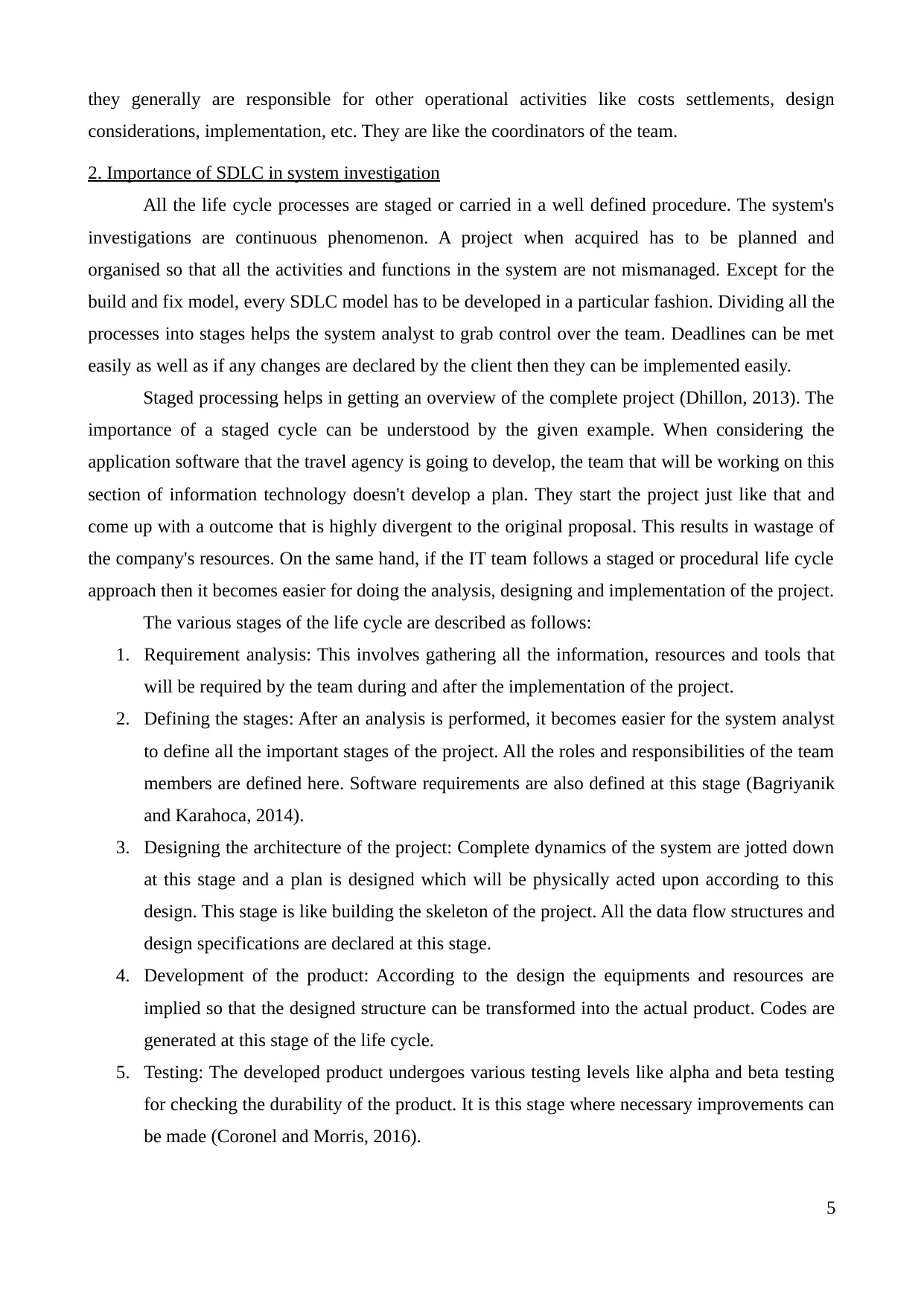
they generally are responsible for other operational activities like costs settlements, design
considerations, implementation, etc. They are like the coordinators of the team.
2. Importance of SDLC in system investigation
All the life cycle processes are staged or carried in a well defined procedure. The system's
investigations are continuous phenomenon. A project when acquired has to be planned and
organised so that all the activities and functions in the system are not mismanaged. Except for the
build and fix model, every SDLC model has to be developed in a particular fashion. Dividing all the
processes into stages helps the system analyst to grab control over the team. Deadlines can be met
easily as well as if any changes are declared by the client then they can be implemented easily.
Staged processing helps in getting an overview of the complete project (Dhillon, 2013). The
importance of a staged cycle can be understood by the given example. When considering the
application software that the travel agency is going to develop, the team that will be working on this
section of information technology doesn't develop a plan. They start the project just like that and
come up with a outcome that is highly divergent to the original proposal. This results in wastage of
the company's resources. On the same hand, if the IT team follows a staged or procedural life cycle
approach then it becomes easier for doing the analysis, designing and implementation of the project.
The various stages of the life cycle are described as follows:
1. Requirement analysis: This involves gathering all the information, resources and tools that
will be required by the team during and after the implementation of the project.
2. Defining the stages: After an analysis is performed, it becomes easier for the system analyst
to define all the important stages of the project. All the roles and responsibilities of the team
members are defined here. Software requirements are also defined at this stage (Bagriyanik
and Karahoca, 2014).
3. Designing the architecture of the project: Complete dynamics of the system are jotted down
at this stage and a plan is designed which will be physically acted upon according to this
design. This stage is like building the skeleton of the project. All the data flow structures and
design specifications are declared at this stage.
4. Development of the product: According to the design the equipments and resources are
implied so that the designed structure can be transformed into the actual product. Codes are
generated at this stage of the life cycle.
5. Testing: The developed product undergoes various testing levels like alpha and beta testing
for checking the durability of the product. It is this stage where necessary improvements can
be made (Coronel and Morris, 2016).
5
considerations, implementation, etc. They are like the coordinators of the team.
2. Importance of SDLC in system investigation
All the life cycle processes are staged or carried in a well defined procedure. The system's
investigations are continuous phenomenon. A project when acquired has to be planned and
organised so that all the activities and functions in the system are not mismanaged. Except for the
build and fix model, every SDLC model has to be developed in a particular fashion. Dividing all the
processes into stages helps the system analyst to grab control over the team. Deadlines can be met
easily as well as if any changes are declared by the client then they can be implemented easily.
Staged processing helps in getting an overview of the complete project (Dhillon, 2013). The
importance of a staged cycle can be understood by the given example. When considering the
application software that the travel agency is going to develop, the team that will be working on this
section of information technology doesn't develop a plan. They start the project just like that and
come up with a outcome that is highly divergent to the original proposal. This results in wastage of
the company's resources. On the same hand, if the IT team follows a staged or procedural life cycle
approach then it becomes easier for doing the analysis, designing and implementation of the project.
The various stages of the life cycle are described as follows:
1. Requirement analysis: This involves gathering all the information, resources and tools that
will be required by the team during and after the implementation of the project.
2. Defining the stages: After an analysis is performed, it becomes easier for the system analyst
to define all the important stages of the project. All the roles and responsibilities of the team
members are defined here. Software requirements are also defined at this stage (Bagriyanik
and Karahoca, 2014).
3. Designing the architecture of the project: Complete dynamics of the system are jotted down
at this stage and a plan is designed which will be physically acted upon according to this
design. This stage is like building the skeleton of the project. All the data flow structures and
design specifications are declared at this stage.
4. Development of the product: According to the design the equipments and resources are
implied so that the designed structure can be transformed into the actual product. Codes are
generated at this stage of the life cycle.
5. Testing: The developed product undergoes various testing levels like alpha and beta testing
for checking the durability of the product. It is this stage where necessary improvements can
be made (Coronel and Morris, 2016).
5
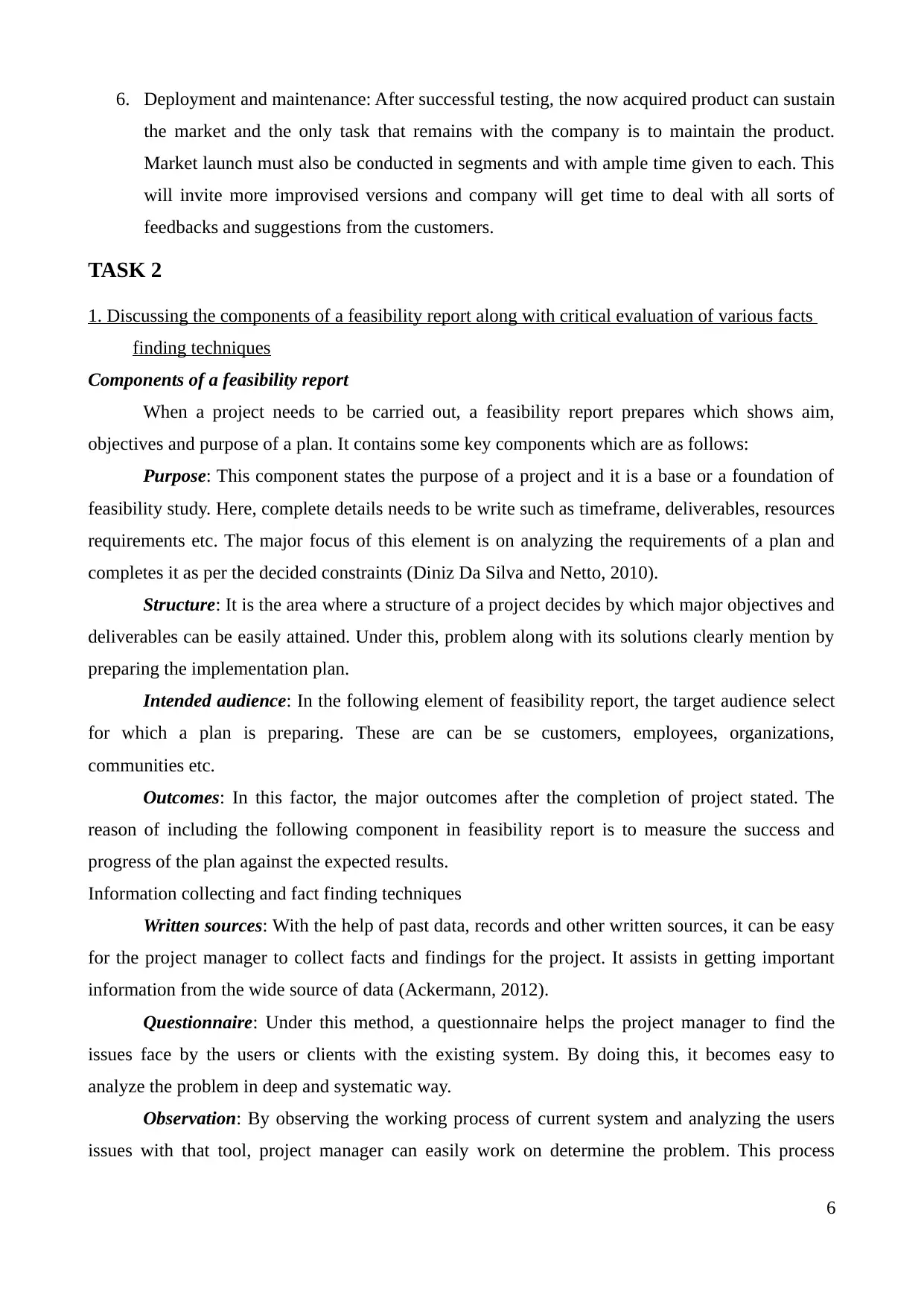
6. Deployment and maintenance: After successful testing, the now acquired product can sustain
the market and the only task that remains with the company is to maintain the product.
Market launch must also be conducted in segments and with ample time given to each. This
will invite more improvised versions and company will get time to deal with all sorts of
feedbacks and suggestions from the customers.
TASK 2
1. Discussing the components of a feasibility report along with critical evaluation of various facts
finding techniques
Components of a feasibility report
When a project needs to be carried out, a feasibility report prepares which shows aim,
objectives and purpose of a plan. It contains some key components which are as follows:
Purpose: This component states the purpose of a project and it is a base or a foundation of
feasibility study. Here, complete details needs to be write such as timeframe, deliverables, resources
requirements etc. The major focus of this element is on analyzing the requirements of a plan and
completes it as per the decided constraints (Diniz Da Silva and Netto, 2010).
Structure: It is the area where a structure of a project decides by which major objectives and
deliverables can be easily attained. Under this, problem along with its solutions clearly mention by
preparing the implementation plan.
Intended audience: In the following element of feasibility report, the target audience select
for which a plan is preparing. These are can be se customers, employees, organizations,
communities etc.
Outcomes: In this factor, the major outcomes after the completion of project stated. The
reason of including the following component in feasibility report is to measure the success and
progress of the plan against the expected results.
Information collecting and fact finding techniques
Written sources: With the help of past data, records and other written sources, it can be easy
for the project manager to collect facts and findings for the project. It assists in getting important
information from the wide source of data (Ackermann, 2012).
Questionnaire: Under this method, a questionnaire helps the project manager to find the
issues face by the users or clients with the existing system. By doing this, it becomes easy to
analyze the problem in deep and systematic way.
Observation: By observing the working process of current system and analyzing the users
issues with that tool, project manager can easily work on determine the problem. This process
6
the market and the only task that remains with the company is to maintain the product.
Market launch must also be conducted in segments and with ample time given to each. This
will invite more improvised versions and company will get time to deal with all sorts of
feedbacks and suggestions from the customers.
TASK 2
1. Discussing the components of a feasibility report along with critical evaluation of various facts
finding techniques
Components of a feasibility report
When a project needs to be carried out, a feasibility report prepares which shows aim,
objectives and purpose of a plan. It contains some key components which are as follows:
Purpose: This component states the purpose of a project and it is a base or a foundation of
feasibility study. Here, complete details needs to be write such as timeframe, deliverables, resources
requirements etc. The major focus of this element is on analyzing the requirements of a plan and
completes it as per the decided constraints (Diniz Da Silva and Netto, 2010).
Structure: It is the area where a structure of a project decides by which major objectives and
deliverables can be easily attained. Under this, problem along with its solutions clearly mention by
preparing the implementation plan.
Intended audience: In the following element of feasibility report, the target audience select
for which a plan is preparing. These are can be se customers, employees, organizations,
communities etc.
Outcomes: In this factor, the major outcomes after the completion of project stated. The
reason of including the following component in feasibility report is to measure the success and
progress of the plan against the expected results.
Information collecting and fact finding techniques
Written sources: With the help of past data, records and other written sources, it can be easy
for the project manager to collect facts and findings for the project. It assists in getting important
information from the wide source of data (Ackermann, 2012).
Questionnaire: Under this method, a questionnaire helps the project manager to find the
issues face by the users or clients with the existing system. By doing this, it becomes easy to
analyze the problem in deep and systematic way.
Observation: By observing the working process of current system and analyzing the users
issues with that tool, project manager can easily work on determine the problem. This process
6
⊘ This is a preview!⊘
Do you want full access?
Subscribe today to unlock all pages.

Trusted by 1+ million students worldwide
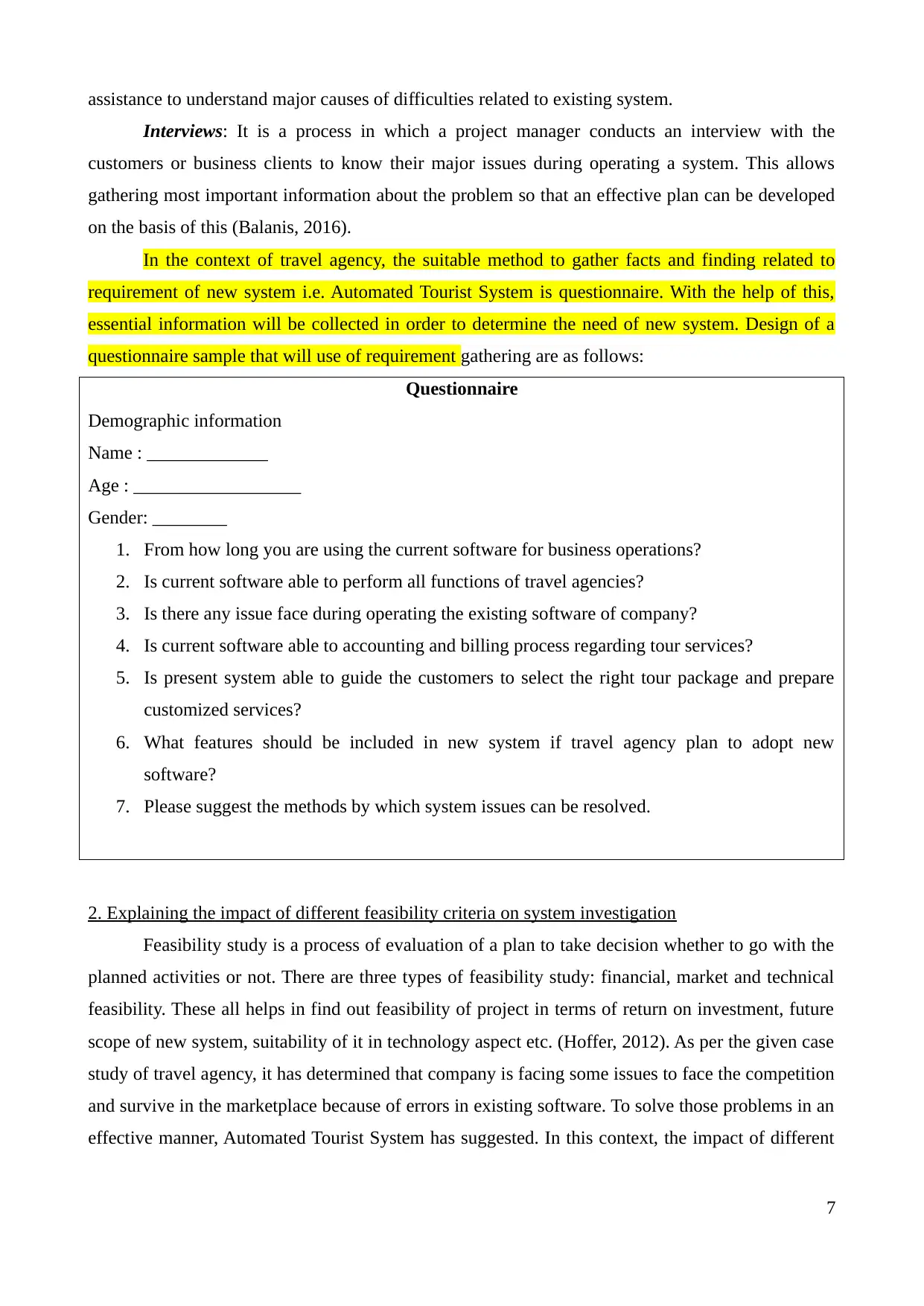
assistance to understand major causes of difficulties related to existing system.
Interviews: It is a process in which a project manager conducts an interview with the
customers or business clients to know their major issues during operating a system. This allows
gathering most important information about the problem so that an effective plan can be developed
on the basis of this (Balanis, 2016).
In the context of travel agency, the suitable method to gather facts and finding related to
requirement of new system i.e. Automated Tourist System is questionnaire. With the help of this,
essential information will be collected in order to determine the need of new system. Design of a
questionnaire sample that will use of requirement gathering are as follows:
Questionnaire
Demographic information
Name : _____________
Age : __________________
Gender: ________
1. From how long you are using the current software for business operations?
2. Is current software able to perform all functions of travel agencies?
3. Is there any issue face during operating the existing software of company?
4. Is current software able to accounting and billing process regarding tour services?
5. Is present system able to guide the customers to select the right tour package and prepare
customized services?
6. What features should be included in new system if travel agency plan to adopt new
software?
7. Please suggest the methods by which system issues can be resolved.
2. Explaining the impact of different feasibility criteria on system investigation
Feasibility study is a process of evaluation of a plan to take decision whether to go with the
planned activities or not. There are three types of feasibility study: financial, market and technical
feasibility. These all helps in find out feasibility of project in terms of return on investment, future
scope of new system, suitability of it in technology aspect etc. (Hoffer, 2012). As per the given case
study of travel agency, it has determined that company is facing some issues to face the competition
and survive in the marketplace because of errors in existing software. To solve those problems in an
effective manner, Automated Tourist System has suggested. In this context, the impact of different
7
Interviews: It is a process in which a project manager conducts an interview with the
customers or business clients to know their major issues during operating a system. This allows
gathering most important information about the problem so that an effective plan can be developed
on the basis of this (Balanis, 2016).
In the context of travel agency, the suitable method to gather facts and finding related to
requirement of new system i.e. Automated Tourist System is questionnaire. With the help of this,
essential information will be collected in order to determine the need of new system. Design of a
questionnaire sample that will use of requirement gathering are as follows:
Questionnaire
Demographic information
Name : _____________
Age : __________________
Gender: ________
1. From how long you are using the current software for business operations?
2. Is current software able to perform all functions of travel agencies?
3. Is there any issue face during operating the existing software of company?
4. Is current software able to accounting and billing process regarding tour services?
5. Is present system able to guide the customers to select the right tour package and prepare
customized services?
6. What features should be included in new system if travel agency plan to adopt new
software?
7. Please suggest the methods by which system issues can be resolved.
2. Explaining the impact of different feasibility criteria on system investigation
Feasibility study is a process of evaluation of a plan to take decision whether to go with the
planned activities or not. There are three types of feasibility study: financial, market and technical
feasibility. These all helps in find out feasibility of project in terms of return on investment, future
scope of new system, suitability of it in technology aspect etc. (Hoffer, 2012). As per the given case
study of travel agency, it has determined that company is facing some issues to face the competition
and survive in the marketplace because of errors in existing software. To solve those problems in an
effective manner, Automated Tourist System has suggested. In this context, the impact of different
7
Paraphrase This Document
Need a fresh take? Get an instant paraphrase of this document with our AI Paraphraser
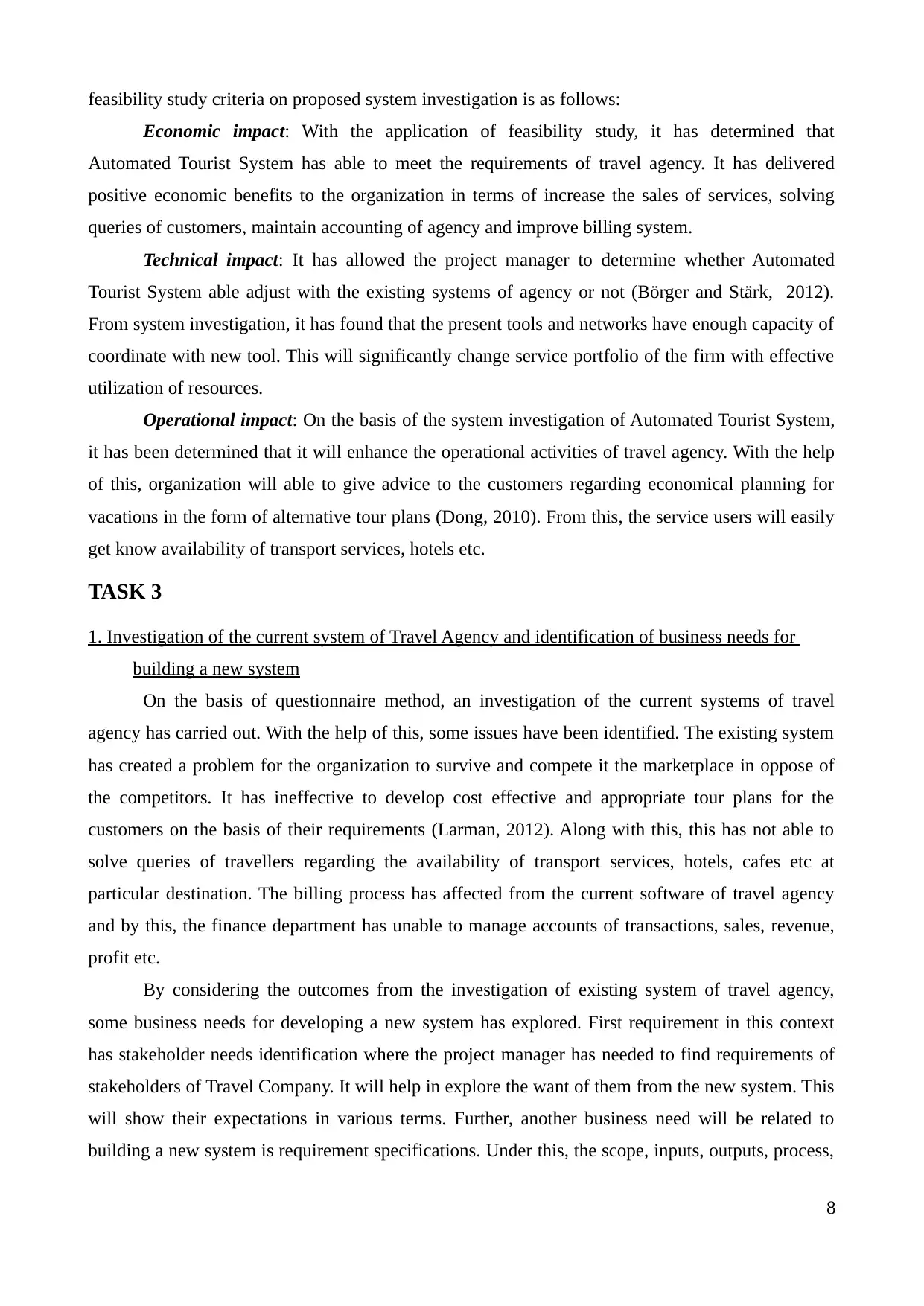
feasibility study criteria on proposed system investigation is as follows:
Economic impact: With the application of feasibility study, it has determined that
Automated Tourist System has able to meet the requirements of travel agency. It has delivered
positive economic benefits to the organization in terms of increase the sales of services, solving
queries of customers, maintain accounting of agency and improve billing system.
Technical impact: It has allowed the project manager to determine whether Automated
Tourist System able adjust with the existing systems of agency or not (Börger and Stärk, 2012).
From system investigation, it has found that the present tools and networks have enough capacity of
coordinate with new tool. This will significantly change service portfolio of the firm with effective
utilization of resources.
Operational impact: On the basis of the system investigation of Automated Tourist System,
it has been determined that it will enhance the operational activities of travel agency. With the help
of this, organization will able to give advice to the customers regarding economical planning for
vacations in the form of alternative tour plans (Dong, 2010). From this, the service users will easily
get know availability of transport services, hotels etc.
TASK 3
1. Investigation of the current system of Travel Agency and identification of business needs for
building a new system
On the basis of questionnaire method, an investigation of the current systems of travel
agency has carried out. With the help of this, some issues have been identified. The existing system
has created a problem for the organization to survive and compete it the marketplace in oppose of
the competitors. It has ineffective to develop cost effective and appropriate tour plans for the
customers on the basis of their requirements (Larman, 2012). Along with this, this has not able to
solve queries of travellers regarding the availability of transport services, hotels, cafes etc at
particular destination. The billing process has affected from the current software of travel agency
and by this, the finance department has unable to manage accounts of transactions, sales, revenue,
profit etc.
By considering the outcomes from the investigation of existing system of travel agency,
some business needs for developing a new system has explored. First requirement in this context
has stakeholder needs identification where the project manager has needed to find requirements of
stakeholders of Travel Company. It will help in explore the want of them from the new system. This
will show their expectations in various terms. Further, another business need will be related to
building a new system is requirement specifications. Under this, the scope, inputs, outputs, process,
8
Economic impact: With the application of feasibility study, it has determined that
Automated Tourist System has able to meet the requirements of travel agency. It has delivered
positive economic benefits to the organization in terms of increase the sales of services, solving
queries of customers, maintain accounting of agency and improve billing system.
Technical impact: It has allowed the project manager to determine whether Automated
Tourist System able adjust with the existing systems of agency or not (Börger and Stärk, 2012).
From system investigation, it has found that the present tools and networks have enough capacity of
coordinate with new tool. This will significantly change service portfolio of the firm with effective
utilization of resources.
Operational impact: On the basis of the system investigation of Automated Tourist System,
it has been determined that it will enhance the operational activities of travel agency. With the help
of this, organization will able to give advice to the customers regarding economical planning for
vacations in the form of alternative tour plans (Dong, 2010). From this, the service users will easily
get know availability of transport services, hotels etc.
TASK 3
1. Investigation of the current system of Travel Agency and identification of business needs for
building a new system
On the basis of questionnaire method, an investigation of the current systems of travel
agency has carried out. With the help of this, some issues have been identified. The existing system
has created a problem for the organization to survive and compete it the marketplace in oppose of
the competitors. It has ineffective to develop cost effective and appropriate tour plans for the
customers on the basis of their requirements (Larman, 2012). Along with this, this has not able to
solve queries of travellers regarding the availability of transport services, hotels, cafes etc at
particular destination. The billing process has affected from the current software of travel agency
and by this, the finance department has unable to manage accounts of transactions, sales, revenue,
profit etc.
By considering the outcomes from the investigation of existing system of travel agency,
some business needs for developing a new system has explored. First requirement in this context
has stakeholder needs identification where the project manager has needed to find requirements of
stakeholders of Travel Company. It will help in explore the want of them from the new system. This
will show their expectations in various terms. Further, another business need will be related to
building a new system is requirement specifications. Under this, the scope, inputs, outputs, process,
8
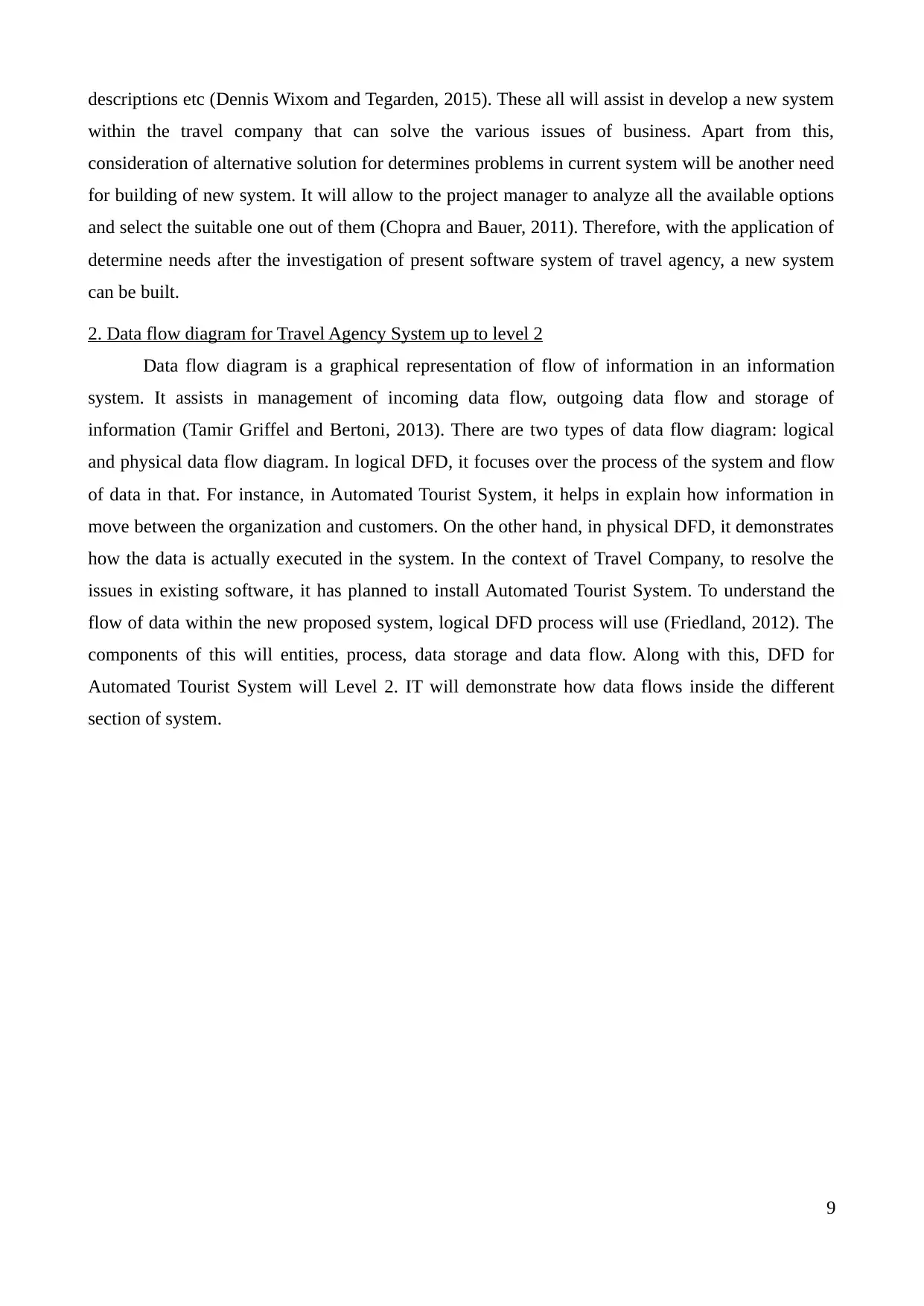
descriptions etc (Dennis Wixom and Tegarden, 2015). These all will assist in develop a new system
within the travel company that can solve the various issues of business. Apart from this,
consideration of alternative solution for determines problems in current system will be another need
for building of new system. It will allow to the project manager to analyze all the available options
and select the suitable one out of them (Chopra and Bauer, 2011). Therefore, with the application of
determine needs after the investigation of present software system of travel agency, a new system
can be built.
2. Data flow diagram for Travel Agency System up to level 2
Data flow diagram is a graphical representation of flow of information in an information
system. It assists in management of incoming data flow, outgoing data flow and storage of
information (Tamir Griffel and Bertoni, 2013). There are two types of data flow diagram: logical
and physical data flow diagram. In logical DFD, it focuses over the process of the system and flow
of data in that. For instance, in Automated Tourist System, it helps in explain how information in
move between the organization and customers. On the other hand, in physical DFD, it demonstrates
how the data is actually executed in the system. In the context of Travel Company, to resolve the
issues in existing software, it has planned to install Automated Tourist System. To understand the
flow of data within the new proposed system, logical DFD process will use (Friedland, 2012). The
components of this will entities, process, data storage and data flow. Along with this, DFD for
Automated Tourist System will Level 2. IT will demonstrate how data flows inside the different
section of system.
9
within the travel company that can solve the various issues of business. Apart from this,
consideration of alternative solution for determines problems in current system will be another need
for building of new system. It will allow to the project manager to analyze all the available options
and select the suitable one out of them (Chopra and Bauer, 2011). Therefore, with the application of
determine needs after the investigation of present software system of travel agency, a new system
can be built.
2. Data flow diagram for Travel Agency System up to level 2
Data flow diagram is a graphical representation of flow of information in an information
system. It assists in management of incoming data flow, outgoing data flow and storage of
information (Tamir Griffel and Bertoni, 2013). There are two types of data flow diagram: logical
and physical data flow diagram. In logical DFD, it focuses over the process of the system and flow
of data in that. For instance, in Automated Tourist System, it helps in explain how information in
move between the organization and customers. On the other hand, in physical DFD, it demonstrates
how the data is actually executed in the system. In the context of Travel Company, to resolve the
issues in existing software, it has planned to install Automated Tourist System. To understand the
flow of data within the new proposed system, logical DFD process will use (Friedland, 2012). The
components of this will entities, process, data storage and data flow. Along with this, DFD for
Automated Tourist System will Level 2. IT will demonstrate how data flows inside the different
section of system.
9
⊘ This is a preview!⊘
Do you want full access?
Subscribe today to unlock all pages.

Trusted by 1+ million students worldwide
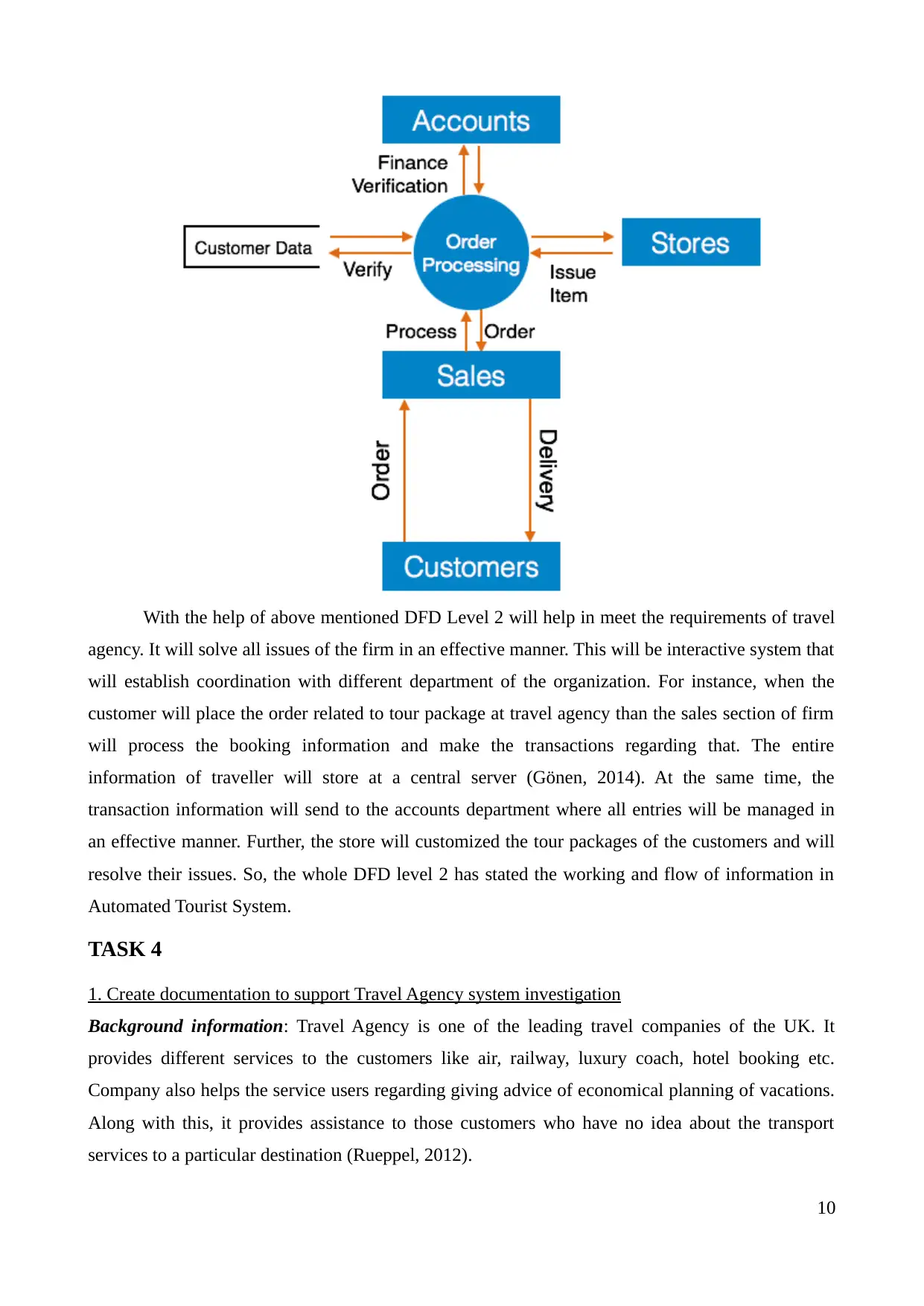
With the help of above mentioned DFD Level 2 will help in meet the requirements of travel
agency. It will solve all issues of the firm in an effective manner. This will be interactive system that
will establish coordination with different department of the organization. For instance, when the
customer will place the order related to tour package at travel agency than the sales section of firm
will process the booking information and make the transactions regarding that. The entire
information of traveller will store at a central server (Gönen, 2014). At the same time, the
transaction information will send to the accounts department where all entries will be managed in
an effective manner. Further, the store will customized the tour packages of the customers and will
resolve their issues. So, the whole DFD level 2 has stated the working and flow of information in
Automated Tourist System.
TASK 4
1. Create documentation to support Travel Agency system investigation
Background information: Travel Agency is one of the leading travel companies of the UK. It
provides different services to the customers like air, railway, luxury coach, hotel booking etc.
Company also helps the service users regarding giving advice of economical planning of vacations.
Along with this, it provides assistance to those customers who have no idea about the transport
services to a particular destination (Rueppel, 2012).
10
agency. It will solve all issues of the firm in an effective manner. This will be interactive system that
will establish coordination with different department of the organization. For instance, when the
customer will place the order related to tour package at travel agency than the sales section of firm
will process the booking information and make the transactions regarding that. The entire
information of traveller will store at a central server (Gönen, 2014). At the same time, the
transaction information will send to the accounts department where all entries will be managed in
an effective manner. Further, the store will customized the tour packages of the customers and will
resolve their issues. So, the whole DFD level 2 has stated the working and flow of information in
Automated Tourist System.
TASK 4
1. Create documentation to support Travel Agency system investigation
Background information: Travel Agency is one of the leading travel companies of the UK. It
provides different services to the customers like air, railway, luxury coach, hotel booking etc.
Company also helps the service users regarding giving advice of economical planning of vacations.
Along with this, it provides assistance to those customers who have no idea about the transport
services to a particular destination (Rueppel, 2012).
10
Paraphrase This Document
Need a fresh take? Get an instant paraphrase of this document with our AI Paraphraser
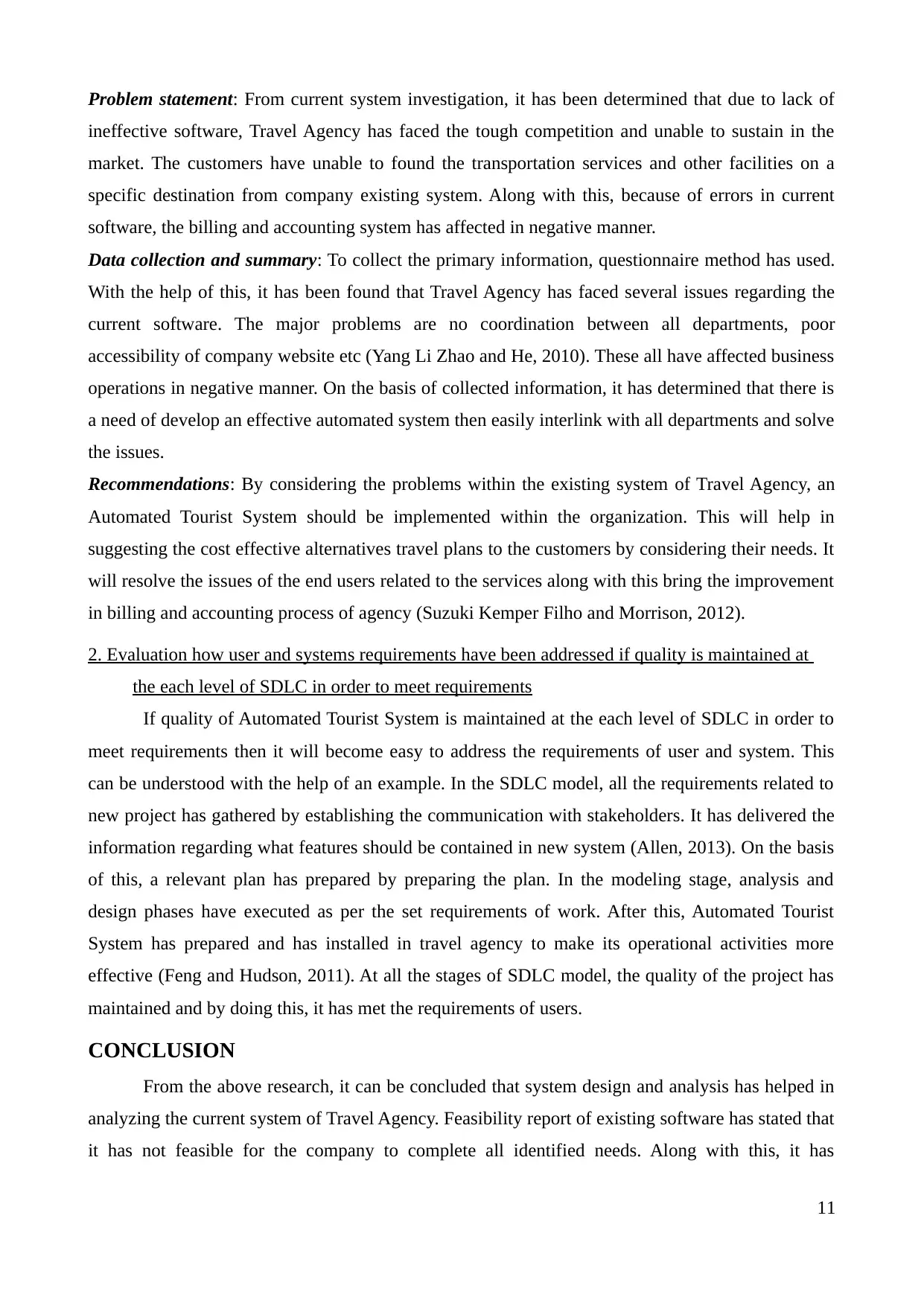
Problem statement: From current system investigation, it has been determined that due to lack of
ineffective software, Travel Agency has faced the tough competition and unable to sustain in the
market. The customers have unable to found the transportation services and other facilities on a
specific destination from company existing system. Along with this, because of errors in current
software, the billing and accounting system has affected in negative manner.
Data collection and summary: To collect the primary information, questionnaire method has used.
With the help of this, it has been found that Travel Agency has faced several issues regarding the
current software. The major problems are no coordination between all departments, poor
accessibility of company website etc (Yang Li Zhao and He, 2010). These all have affected business
operations in negative manner. On the basis of collected information, it has determined that there is
a need of develop an effective automated system then easily interlink with all departments and solve
the issues.
Recommendations: By considering the problems within the existing system of Travel Agency, an
Automated Tourist System should be implemented within the organization. This will help in
suggesting the cost effective alternatives travel plans to the customers by considering their needs. It
will resolve the issues of the end users related to the services along with this bring the improvement
in billing and accounting process of agency (Suzuki Kemper Filho and Morrison, 2012).
2. Evaluation how user and systems requirements have been addressed if quality is maintained at
the each level of SDLC in order to meet requirements
If quality of Automated Tourist System is maintained at the each level of SDLC in order to
meet requirements then it will become easy to address the requirements of user and system. This
can be understood with the help of an example. In the SDLC model, all the requirements related to
new project has gathered by establishing the communication with stakeholders. It has delivered the
information regarding what features should be contained in new system (Allen, 2013). On the basis
of this, a relevant plan has prepared by preparing the plan. In the modeling stage, analysis and
design phases have executed as per the set requirements of work. After this, Automated Tourist
System has prepared and has installed in travel agency to make its operational activities more
effective (Feng and Hudson, 2011). At all the stages of SDLC model, the quality of the project has
maintained and by doing this, it has met the requirements of users.
CONCLUSION
From the above research, it can be concluded that system design and analysis has helped in
analyzing the current system of Travel Agency. Feasibility report of existing software has stated that
it has not feasible for the company to complete all identified needs. Along with this, it has
11
ineffective software, Travel Agency has faced the tough competition and unable to sustain in the
market. The customers have unable to found the transportation services and other facilities on a
specific destination from company existing system. Along with this, because of errors in current
software, the billing and accounting system has affected in negative manner.
Data collection and summary: To collect the primary information, questionnaire method has used.
With the help of this, it has been found that Travel Agency has faced several issues regarding the
current software. The major problems are no coordination between all departments, poor
accessibility of company website etc (Yang Li Zhao and He, 2010). These all have affected business
operations in negative manner. On the basis of collected information, it has determined that there is
a need of develop an effective automated system then easily interlink with all departments and solve
the issues.
Recommendations: By considering the problems within the existing system of Travel Agency, an
Automated Tourist System should be implemented within the organization. This will help in
suggesting the cost effective alternatives travel plans to the customers by considering their needs. It
will resolve the issues of the end users related to the services along with this bring the improvement
in billing and accounting process of agency (Suzuki Kemper Filho and Morrison, 2012).
2. Evaluation how user and systems requirements have been addressed if quality is maintained at
the each level of SDLC in order to meet requirements
If quality of Automated Tourist System is maintained at the each level of SDLC in order to
meet requirements then it will become easy to address the requirements of user and system. This
can be understood with the help of an example. In the SDLC model, all the requirements related to
new project has gathered by establishing the communication with stakeholders. It has delivered the
information regarding what features should be contained in new system (Allen, 2013). On the basis
of this, a relevant plan has prepared by preparing the plan. In the modeling stage, analysis and
design phases have executed as per the set requirements of work. After this, Automated Tourist
System has prepared and has installed in travel agency to make its operational activities more
effective (Feng and Hudson, 2011). At all the stages of SDLC model, the quality of the project has
maintained and by doing this, it has met the requirements of users.
CONCLUSION
From the above research, it can be concluded that system design and analysis has helped in
analyzing the current system of Travel Agency. Feasibility report of existing software has stated that
it has not feasible for the company to complete all identified needs. Along with this, it has
11
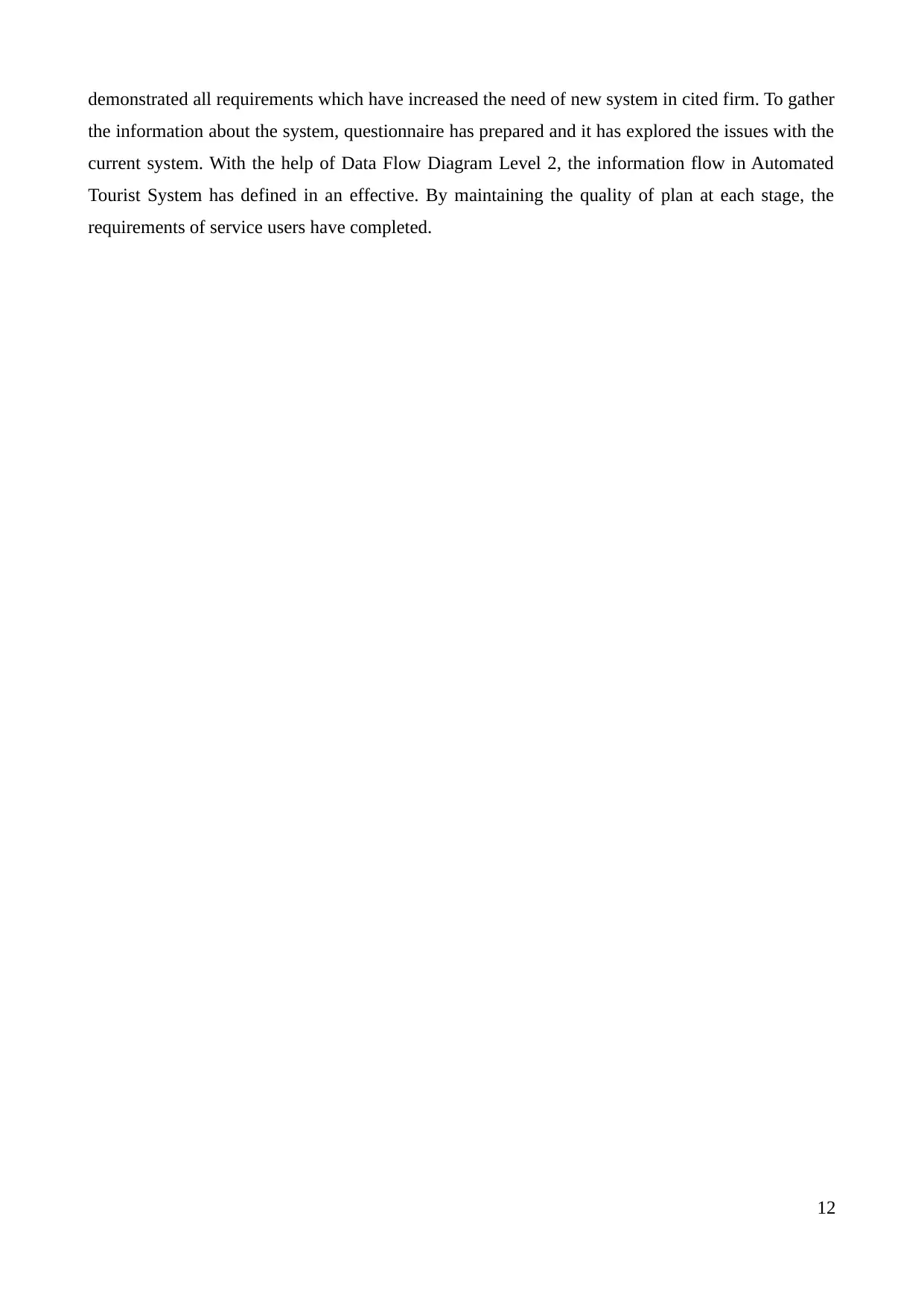
demonstrated all requirements which have increased the need of new system in cited firm. To gather
the information about the system, questionnaire has prepared and it has explored the issues with the
current system. With the help of Data Flow Diagram Level 2, the information flow in Automated
Tourist System has defined in an effective. By maintaining the quality of plan at each stage, the
requirements of service users have completed.
12
the information about the system, questionnaire has prepared and it has explored the issues with the
current system. With the help of Data Flow Diagram Level 2, the information flow in Automated
Tourist System has defined in an effective. By maintaining the quality of plan at each stage, the
requirements of service users have completed.
12
⊘ This is a preview!⊘
Do you want full access?
Subscribe today to unlock all pages.

Trusted by 1+ million students worldwide
1 out of 17
Related Documents
Your All-in-One AI-Powered Toolkit for Academic Success.
+13062052269
info@desklib.com
Available 24*7 on WhatsApp / Email
![[object Object]](/_next/static/media/star-bottom.7253800d.svg)
Unlock your academic potential
Copyright © 2020–2025 A2Z Services. All Rights Reserved. Developed and managed by ZUCOL.





